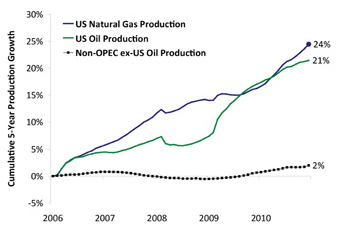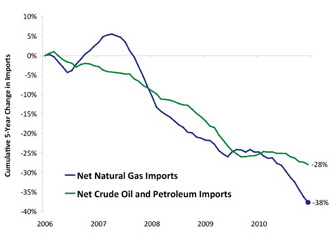Personal Wealth Management /
The American Energy Revolution
Thanks to new technologies, the US is rapidly increasing domestic sources of energy.
If you’re looking for a bit of a respite from the nonstop debt-ceiling debate, here’s some not-so-trivial trivia:Natural gas production has grown 24% in the United States over the past 5 years. Why? New technological advances in fracking (hydraulic fracturing) and directional drilling (i.e., drilling at an angle or horizontally instead of vertically). These aren’t new technologies—but increasing energy prices and improving technology has made them increasingly economically viable. So viable, North America is now a net exporter of natural gas and has overtaken Russia as the world’s largest producer.
And while many decry US reliance on foreign oil producers, thanks to fracking, oil production (including non-crude liquid fuels) has also been steadily increasing over the last five years—up 21%. (See Exhibit 1.) This while non-OPEC production (excluding the US) has largely been flat.
Exhibit 1: US Oil & Gas Production: Cumulative 5-Year Growth
Source: EIA Short-Term Energy Outlook, June 2011. All data reflects cumulative change in 12-month moving average (7/31/06-6/30/2011).
4D seismic, enhanced oil recovery and ultra deepwater drilling in the Gulf of Mexico have also contributed to the US’s production gain. And these gains have been reflected in import/export figures for oil and gas of late—as shown in Exhibit 2, natural gas and oil imports have fallen over the last five years. The reduction in imports isn't simply due to reduced energy usage over that period (though in some ways, like oil consumption per dollar of GDP, that's happened)—we’re just using new technologies to produce more closer to home. And this is no marginal net benefit. OPEC spare production capacity continues to be squeezed—meaning supply increases there are more difficult to achieve.
Exhibit 2: 5-Year Decline in US Net Imports of Oil & Gas
Source: EIA Short-Term Energy Outlook, June 2011. All data reflects cumulative change in 12-month moving average (7/31/06-6/30/2011).
Advances in hydraulic fracturing aren’t limited to North America alone. European producers have adopted the technology as well, but are still behind their counterparts across the pond. Though they have plenty of incentive to keep pushing forward—there may be as much as 60 years worth of recoverable unconventional gas in Europe. And that’s from those reserves that are currently known. (The funny thing about recovering energy is the more we remove, the more we tend to find.)
So why isn’t everyone on the frack wagon? There’s an ongoing debate on whether the benefits of fracking outweigh the environmental impact. Fair enough—but we think the benefits decidedly do outweigh. (And so does the state of Pennsylvania, which is seeing something of an energy boom super-greenie New York is hoping to emulate.) If New York can come around, so too can Europe. In the meantime, the US is in the fracking lead.
If you would like to contact the editors responsible for this article, please message MarketMinder directly.
*The content contained in this article represents only the opinions and viewpoints of the Fisher Investments editorial staff.
Get a weekly roundup of our market insights
Sign up for our weekly e-mail newsletter.

You Imagine Your Future. We Help You Get There.
Are you ready to start your journey to a better financial future?

Where Might the Market Go Next?
Confidently tackle the market’s ups and downs with independent research and analysis that tells you where we think stocks are headed—and why.







